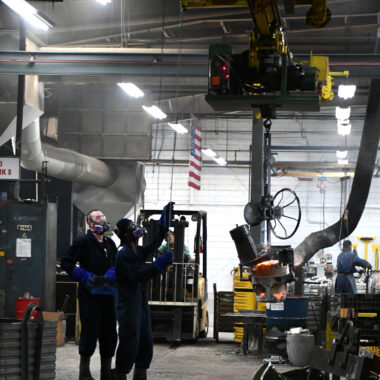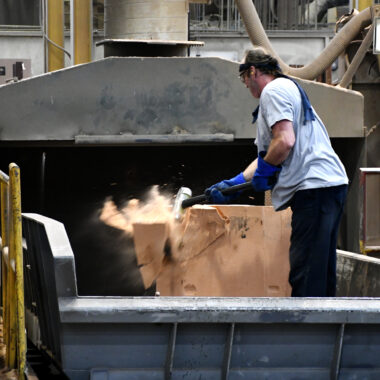The Ultimate Resource for Casting Aluminum Illinois
The Ultimate Resource for Casting Aluminum Illinois
Blog Article
Innovation in Aluminum Spreading: Cutting-Edge Techniques for Modern Creators
What absolutely establishes these developments apart are the sustainable light weight aluminum alloys being established and the high-pressure die casting strategies that are transforming the industry. Join us as we discover the leading edge of aluminum casting advancement, where technology satisfies imagination to redefine what is feasible in the world of steel casting.

Advanced 3D Printing Methods
Utilizing advanced additive production procedures, progressed 3D printing strategies have transformed the manufacturing of complex and personalized light weight aluminum components. By using high-precision printers that can collaborate with aluminum powders or filaments, suppliers can develop intricate geometries and styles that were previously unattainable with standard production approaches.
Among the key advantages of advanced 3D printing in aluminum component manufacturing is the capability to attain lightweight yet long lasting structures. This is particularly helpful in markets such as aerospace and automobile, where weight reduction is essential for enhancing fuel performance and overall performance. Furthermore, the personalization choices used by 3D printing enable the manufacturing of one-of-a-kind and customized components that satisfy certain needs, bring about boosted performance and performance.
Furthermore, the efficiency of the 3D printing process decreases material waste and decreases the overall manufacturing time, making it an affordable solution for making aluminum parts. As innovation remains to breakthrough, the capacities of 3D printing in light weight aluminum manufacturing are expected to broaden, offering also higher possibilities for technology in numerous industries.
Computer-Aided Design Advancements
With the advancements in sophisticated 3D printing techniques for aluminum elements, the integration of Computer-Aided Style (CAD) software application has become significantly crucial in driving advancement and effectiveness in the production procedure. CAD advancements have changed the way designers and engineers develop aluminum spreading molds by supplying specific electronic modeling capabilities. These software tools permit the creation of intricate styles and simulations that optimize the spreading procedure, causing better parts.
One of the key advantages of CAD in aluminum spreading is the capability to detect potential problems early in the layout phase, minimizing expensive errors and revamp throughout production. By mimicing the casting procedure virtually, developers can examine aspects such as cooling down rates, product circulation, and architectural stability before a physical mold and mildew is created. This positive approach not only saves time and resources yet also makes certain that the final light weight aluminum elements fulfill the wanted requirements.
Moreover, CAD software enables quick versions and modifications to designs, helping with quick prototyping and modification to satisfy certain demands. By leveraging CAD innovations in light weight aluminum casting, suppliers can simplify their procedures, boost item quality, and remain at the center of technology in the industry.
High-Pressure Die Casting Methods
High-pressure die casting approaches are widely recognized for their performance and accuracy in producing complex light weight aluminum elements. By using high stress to require liquified aluminum into intricate mold and mildews at quick rates, this strategy permits the development of detailed and dimensionally accurate components. One of the vital benefits of high-pressure die casting is its ability to produce components with thin wall surfaces and great information, making it excellent for applications where light-weight yet solid components are required.
The procedure begins with the prep work of the die, which is commonly made from hardened tool steel and contains two fifty percents that form the desired component shape. The liquified light weight aluminum is then infused right into the die cavity under high pressure, making sure that the product fills all the intricate attributes of the mold. When the aluminum strengthens, the die opens up, disclosing the finished part ready for any needed post-processing.
High-pressure die spreading is frequently used in different sectors, consisting of auto, aerospace, and electronic devices, where high-volume production of complex aluminum elements is needed. casting aluminum illinois. Its capability to provide tight resistances, superb surface finishes, and cost-effective production makes it a favored choice for modern-day developers intending to introduce in aluminum casting techniques
Lasting Aluminum Alloys Growth

One technique to sustainable light weight aluminum alloy navigate to this website development entails incorporating recycled light weight aluminum web content right into the alloy composition. By utilizing recycled aluminum, makers can lower energy intake and greenhouse gas emissions associated with main aluminum manufacturing. In addition, reusing light weight aluminum helps draw away waste from land fills, adding to an extra circular economic situation.
Furthermore, scientists are checking out new alloying components and processing techniques to boost the sustainability of aluminum alloys. By maximizing alloy make-ups and manufacturing procedures, it is feasible to improve the recyclability, durability, and total ecological performance of aluminum products.

Automation and Robotics Assimilation
In the realm of lasting aluminum alloys growth, the integration of automation and robotics is transforming producing processes, leading the way for raised effectiveness and accuracy in manufacturing. Automation and robotics are simplifying standard casting methods, using many benefits to designers in the light weight aluminum market. By incorporating automation right into the casting procedure, repeated tasks that were once labor-intensive can now be effectively managed by robot systems, reducing the danger of human error and raising total productivity.
Automated systems can function all the time, ensuring a constant production cycle that decreases downtime and takes full advantage of result. Robotics integration enables intricate molds and elaborate layouts to be produced with unrivaled precision, satisfying the demands of contemporary designers for high-grade aluminum components. The use of automation in casting procedures advertises a safer working environment by lessening the direct exposure of workers to dangerous conditions.
Final Thought
Advanced 3D printing techniques, computer-aided layout advancements, high-pressure die casting techniques, sustainable aluminum alloys growth, and automation and robotics combination have all contributed to the modernization of the casting process. The future of light weight aluminum casting is brilliant with constant technology and technological advancements.
What truly sets these technologies apart are the sustainable light weight aluminum alloys being established and the high-pressure die casting methods that are revolutionizing the market. Join us as we check out the center of aluminum spreading innovation, where modern technology meets creativity to redefine what is possible in the globe of steel casting.
One method to lasting light weight aluminum alloy advancement includes including recycled aluminum web content right into the alloy composition - casting aluminum illinois. By using more tips here recycled light weight aluminum, suppliers can lower energy usage and greenhouse gas exhausts connected with key aluminum production. Advanced 3D printing techniques, computer-aided design developments, high-pressure die casting approaches, lasting aluminum alloys development, and automation and robotics combination have all added to the modernization of the casting procedure
Report this page